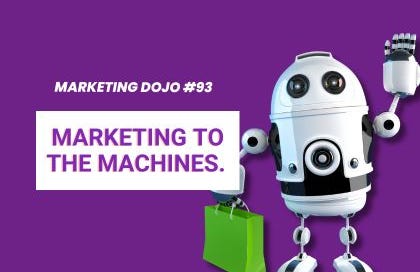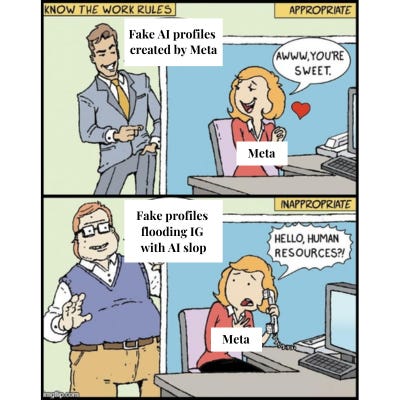Marketing Dojo #93: 🤖 Marketing To The Machines.🚀
Marketing to agents, what does the marketing team do all day?, AI hastens enshittifcation of IG and more.
Welcome to the 93rd issue of Marketing Dojo!
I am no longer a marketer.
At least not by my job title.
For the first time in over a decade and a half, "marketing" has disappeared from my designation.
But don't hit that unsubscribe button just yet!
I'm stepping into a global product role at 3M, focusing on New Product Introductions. While my business card might not scream "marketer" anymore, I'll still be deep in the trenches with two of marketing's core Ps—Product and Pricing. (Professor Kotler would approve!)
2025 is shaping to be a year of steep learning curves!
But enough about me—here's what we'll be diving into today:
📡 Marketing to agents
😂 Meme-time: Meta's AI profiles
📊 Marketing's true contribution
🤔 That's interesting
And lots more.
Haven't subscribed yet? Consider hitting that subscribe button. Every Wednesday, I distil the marketing world's chaos into bite-sized, scroll-friendly insights.
And to my existing subscribers - your support keeps this newsletter growing. Thank you for being part of this journey.
Convincing Bots > Convincing Humans?
I just watched a video that made me spill my coffee. Perplexity CEO Aarvind Srinivas dropped a perspective bomb about the future of advertising, and I can't stop thinking about it.
Here's a quick TL;DR,
Picture this: You’re planning a family holiday.
But instead of spending hours comparing flights, hotels, and activities, you outsource the entire process to an AI agent. It evaluates options, makes decisions based on your preferences, and finalizes the booking—all without you lifting a finger.
You see no ads and make no comparisons. In return, you pay for the bot via a subscription, per-use fee, or commission paid by the companies vying for your wallet.
Far-fetched? Maybe not. This agentic future is already a stated goal of many organizations in the AI race.
Think about what this means for advertising:
Brands would need to convince AI agents, not humans
Traditional emotional appeals become irrelevant
The entire advertising industry, built on human psychology, could crumble
Could this mean the end of advertising as we know it? Maybe.
As marketers, we need to start thinking about this now. Because while it sounds like science fiction, remember—so did smartphones just 20 years ago.
Big Tech's 2024 Resolution: Test How Much AI Users Can Stomach
Remember when social media was about connecting with real people? Meta apparently doesn't.
Meta is doubling down on AI, but it is not always where it adds value. Case in point: the Large Language Model (LLM) that now sits awkwardly in my WhatsApp chats.
It doesn't stop there. Back in September 2023, Meta began rolling out AI-generated profiles on Instagram. Meet Liv, Carter, and Grandpa Brian—some of the more (in)famous examples.
These AI accounts were designed to generate content and interact with users as if they were real people.
The result?
Widespread anger and resentment.
Users quickly labelled the profiles as "cringe" and "fake" because, well, they are fake. Experts weren't impressed, either. Many pointed out how Meta's bots are contributing to the very "AI slop" that platforms like Instagram should be fighting.
Last heard, Meta has been trying to delete these bots from its platform. But the message is loud and clear - AI will accelerate the enshittifcation of social media platforms. Worse still, platforms like IG will continue contributing to the slop instead of combatting it!
The first meme of the year is dedicated to Meta's overenthusiasm for AI-everything.
"That's interesting!"
The magic words every marketer hopes to spark in their audience. But creating content that earns this reaction? Not so simple.
In 1971, sociologist Murray Davis wrote an essay titled "That's Interesting" to uncover why some theories stick while others don't.
His key insight?
𝐓𝐡𝐞𝐨𝐫𝐢𝐞𝐬 𝐭𝐡𝐚𝐭 𝐜𝐡𝐚𝐥𝐥𝐞𝐧𝐠𝐞 𝐰𝐡𝐚𝐭 𝐩𝐞𝐨𝐩𝐥𝐞 𝐭𝐚𝐤𝐞 𝐟𝐨𝐫 𝐠𝐫𝐚𝐧𝐭𝐞𝐝 𝐚𝐫𝐞 𝐟𝐚𝐫 𝐦𝐨𝐫𝐞 𝐞𝐧𝐠𝐚𝐠𝐢𝐧𝐠 𝐭𝐡𝐚𝐧 𝐭𝐡𝐨𝐬𝐞 𝐭𝐡𝐚𝐭 𝐚𝐟𝐟𝐢𝐫𝐦 𝐭𝐡𝐞𝐢𝐫 𝐛𝐞𝐥𝐢𝐞𝐟𝐬.
Consider these campaigns:
• Volkswagen's "Think Small"—redefining what a great car looks like.
• Dove's "Real Beauty"—challenging traditional beauty standards.
• Nike's "Winning Isn't for Everyone"—shaking up the idea of sportsmanship spirit.
Each one disrupted deeply held assumptions and left a lasting impact.
This applies to personalities such as Gary V, Prof Scott Galloway, and Mark Ritson. All three gentlemen often hold controversial opinions that contradict the conventional wisdom.
Memorability, a cornerstone of brand building, often boils down to this: Does your marketing or content challenge what your audience assumes to be true?
Do you agree?
What is marketing’s true contribution?
Picture this: It's my first B2B marketing role, and a stakeholder drops the question, "What does success look like?".
I found myself tongue-tied.
I remember rattling off a bespoke version of market share measurement.
There was a problem, though - every team in the organization was chasing the same metric. When everyone's rowing toward the same shore, how do you know which oar is actually moving the boat?
And because the correlation between efforts and results was hazy, funding and resources were often dictated by a leader's opinions or whims rather than data.
After months of struggle, I finally landed on a single, clear north-star metric: New Customer Growth.
As is characteristic of a large company, it took several more months to figure out how to measure it, set fair targets, and communicate it across the organization.
But it was worth it. Why?
Because even good marketing strategies often get buried under the weight of vague KPIs.
Stage 2 Foundation’s article on Marketing’s True Contribution is a must-read for anyone rethinking ROI. While it's written for startups, the principles apply whether you're a scrappy newcomer or an established giant.
Here’s some practical advice from the article:
Start with your Go-To-Market (GTM) Model.
If you run a sales-led operation, focus on pipeline contribution. If you are going product-led, watch those activated users like a hawk.
Focus on Outcomes and Quality.
Don't settle for surface-level metrics. Push deeper. Instead of counting leads, measure the qualified pipeline. Rather than total signups, track users who stick around.
Align Marketing Investments.
Each marketing function should have its own Key Performance Indicators (KPIs), which directly contribute to the team-wide North Star metric.
Of course, it gets messy. The first fire to fight? Attribution. The second? Over-indexing on easy-to-measure performance metrics, which often undervalue branding and the so-called “dark funnel.”
But despite the challenges, articulating marketing's true contribution pays off in three key ways:
Filters the noise. In a world drowning in data, it helps focus on what truly matters.
Creates accountability. A clear metric anchors marketing teams in measurable outcomes.
Links efforts to results. Goodbye opinions, hello facts and figures.
Perfect metrics don’t exist, but good ones drive better decisions—which sets strong marketing apart.
Short Stuff:
Brands are hesitant to advertise on news websites. (It is getting unfeasible to create serious news).
AI Prompt library for B2B marketing (Save it for later).
Spotify launched its partner program, which allows podcasters to monetize their content (About time).
That’s a wrap on this week. Thank you for your time and attention. If you liked this week’s newsletter or found something interesting, please give me a like ❤️ or drop a comment🗨️. Your support helps drive the newsletter's discoverability.
I will see you in your inbox next Wednesday.
Regards,






Also, on the note of AI agents, you should also check out "Rabbit" if you haven't already - https://www.youtube.com/watch?v=22wlLy7hKP4
Thanks Garima! The prompts were good and i discovered a new perspective. Best of luck in your new role!